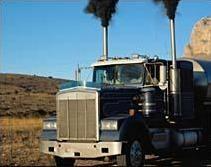Can you imagine a world where energy is produced without negative environmental impacts? A life on a healthy planet with a clean atmosphere, safe from polluting hydrocarbons such as oil, coal, and natural gas, or the dangers of nuclear radiation?
Can you envision a time when on-site renewable and alternative energy systems provide a more equitable distribution of electricity and a better standard of living for all of the world’s people?
Do you foresee a future where a full-fledged energy revolution has minimized the human impact on the biosphere and changed everyone’s life for the better?
Ready or not, this exciting frontier is right around the corner and heading your way. Fuel cells, electric-hybrid vehicles, and high-tech, energy-efficient homes and appliances are just the tip of the iceberg and represent the first surge of an energy revolution that will transform the human condition in the 21st century.
A new age is dawning, and clean, renewable energy systems are the vanguard of the next energy revolution. Behind the wind turbines and solar panels will come a new understanding of physics and exotic energy technologies that derive power from the invisible sea of energy that permeates the Universe.
We are literally immersed in this zero-point energy, which, if tapped, will solve the energy crisis forever. Existing reserves of fossil fuels are a one-time gift from the planet and are now being consumed as if there were no tomorrow, with little consideration for future generations. If scientists are successful in their efforts to gather energy from the vacuum of space, smokestacks and air pollution will be a distant memory, and a clean and viable global ecosystem will be passed on to each succeeding generation. After all, we do not inherit the Earth from our ancestors; we borrow it from our children.
Optimists claim that there is enough oil worldwide to last another 40 years. Many experts consider it to be much less. In some ways, the shrill, hyperbole warning of petroleum’s imminent demise is a bit misleading. We are not running out of fossil fuels per se but running out of liquid fuels that are cheap to produce. There are still significant oil and natural gas reserves, but they are diminishing and will be more costly to extract.
There are also coal reserves if we can find a way to use them without damaging the environment. Unfortunately, fossil fuels are killing us and destroying our planet’s health.
We live in troubled times, and, if scientists are right, the next stretch of road looks rough indeed. Climatologists warn of rapid climate change and global warming caused by increasing concentrations of greenhouse gases in the atmosphere. Geologists caution that in the next couple of decades, the planet’s petroleum and natural gas supplies will reach their high point of production and decline forever after.
Coal is a gross polluter, and nuclear fission is uneconomical when capital investment, radioactive waste management, and long-term storage of hazardous materials are factored in. A burgeoning human population is overloading the planet’s ability to support it, and disturbing trends indicate that we are stressing the biosphere to the breaking point. Unless these destructive activities are reversed, future generations will struggle to survive on a planet suffering from depleted resources, polluted air and water, and unpredictable weather patterns.
Our increasing demand for electricity and transportation fuel is gutting the planet’s limited natural resources, and the byproducts of our fossil-fuel-based economy have degraded the global environment. Drilling for oil in environmentally sensitive areas does not make for an intelligent comprehensive energy policy, nor does gutting federal funding for energy-efficiency R&D and renewable energy research.
Attempts to maintain the illusion of perpetual low-cost energy have distorted US energy markets for decades, leaving American consumers with homes, appliances, personal vehicles, and equipment that would be expensive to operate if energy costs suddenly increased. It’s time to rein in America’s profligate rate of energy and resource consumption and waste; we must take responsibility for our environmental impact.
To develop new-energy systems that will complement wind and solar power to help replace fossil fuels and nuclear power, the United States must implement a national energy policy that provides an informed and balanced review of the full range of new and emerging energy technologies that are struggling due to lack of R&D funding and professional organization. There is currently a movement in the US Department of
Energy to initiate a review program to critically analyze potential new-energy and breakthrough propulsion technologies, but government approval and adequate funding are far from guaranteed.
Experts doubt that renewable resources like wind and solar power will support the energy-hungry industrialized nations, let alone a world population with more than six billion people and growing fast. Aggressive and coordinated research and development in revolutionary energy systems are necessary to sustain the quality of life associated with an energy-intensive lifestyle.
Non-Renewable Energy
The world is addicted to cheap, readily available oil. It’s a polluting energy source that exists in limited amounts, the bulk of which is concentrated in the politically volatile Persian Gulf.
Whether your nation’s energy of choice is fossil fuel, nuclear energy, or a combination of both, it is a deadly addiction. History will repeat itself in the convulsions of war, starvation, and political upheavals when the current cheap supplies start dwindling unless we prepare now for a future based on new energy systems.
Back in the 1960s, predictions that the United States would have pumped over half of its total supply of oil by the 1970s met with stiff opposition from the energy dealers and by governments buoyed up by fuel profits. They were wrong, the U.S. is now well past its halfway point in consuming its inexpensive oil reserves.
Nuclear energy was touted as an unlimited panacea, destined to be so cheap that electric companies wouldn’t even put meters on houses. Conventional oil is running out, and we now know nuclear fuel is quite limited in supply as well.
In the face of the world’s greatest impending disaster, nations still doctor their listed reserves to preserve global credit ratings and credibility and to placate their populations. As an example, the $50 billion loan to Mexico from the U.S. was based on collateral in the form of profits on oil sales – collateral that was exaggerated and insufficient.
OPEC countries are rewarded for artificial reserve inflation by being allowed to pump more oil per year, thus boosting their oil-based economies. The world’s population is based on food grown with petroleum-based fertilizers and cultivated by machines running on cheap fuel. As competition for this limited resource increases, starvation, population collapse, and global conflicts will ensue.
Burning Fossil Fuel
Burning fossil fuel or splitting atoms to power a car or boil water is like throwing antique furniture into your fireplace in order to heat your house. It wastes precious resources better suited to producing new materials or diagnosing medical conditions to improve health, rather than pouring it into gas-guzzling automobile engines or electric power plants that degrade the environment. But what choices do we have? Is there reason to hope?
Low Sulfur Diesel
Diesel fuel is derived from light virgin gas oil that is produced from the distillation of crude oil. Low Sulfur Diesel is produced in the refineries with a hydrodesulfurization unit and has a sulfur content of 350 ppm. High levels of sulfur are undesirable as during combustion these are converted into volatile sulfur oxides, which lead to increased engine wear. They also contribute directly to acid rain and form solid sulfates, which add to the particulate matter in the exhaust gas.
Ultra Low Sulfur Diesel
Ultra low sulfur diesel is produced in much the same way as normal diesel but requires the fuel to go through an extra series of processing steps which are typically accomplished using a two-stage high severity hydrodesulfurization unit.
This unit comprises a cobalt-molybdenum catalyst in the first stage and nickel molybdenum catalyst in the second stage. Hydrogenation of diesel over the Co-Mo catalyst removes mostly sulfur associated with aliphatic hydrocarbons.
A more active Ni-Mo catalyst facilitates the hydrogenation of aromatic sulfur as well as saturation of aromatic hydrocarbons. This results in a higher cetane number and affects the physical properties of the resulting product, changing things like the cloud point and viscosity of the final diesel fuel product.
Diesel Engines vs Gasoline Engines
Diesel cars are better than petrol cars when it comes to carbon dioxide, the global warming gas.
- Diesel fuel has 20% more energy than gasoline, hence it gets better miles per gallon of fuel used.
- Diesel engines operate at a higher compression ratio, hence it operates more efficiently.
- Diesel cars are better than petrol cars when it comes to carbon monoxide, a poison.
Is there less power available when using biodiesel?
There is less energy in a gallon of biodiesel than there is in No.2 diesel fuel. This is one of the many reasons that blends of B5 and B20 are most commonly seen on the market. Blending biodiesel with petro-based diesel fuel tends to mitigate the effect of the lower calorific value of biodiesel while the user still gains many of the benefits accrued from using biodiesel.
Why is fossil-fuel based diesel exhaust so dangerous?

Unfortunately, it is a common experience to see and smell a black cloud of smoke rising from behind a diesel-powered vehicle. Fossil-fuel based diesel exhaust contains potent carcinogens and diesel particulates increase the risk of asthma, lung disease as well as cancer.
Nearly a half-million people in the Dallas-Fort Worth region live with diseases that are aggravated by air pollution, according to the American Lung Association. In the Dallas/Fort Worth Metroplex, there are 63,758 children with asthma, 208,835 adults with asthma, 137,717 people with chronic bronchitis, and 36,099 people with emphysema.
Petroleum and Nonrenewable Energy
Petroleum products are refined from crude petroleum that is pumped from wells in many parts of the world. Crude petroleum is, in turn, refined in many refineries in the world.
Refineries are of several types, but the most important process involves the “cracking” and distillation of the crude into a wide range of products that form the backbone of the world’s energy and petrochemical industries. The lighter petroleum fuels or “fractions” (benzene, kerosene, diesel) are the most widely used petroleum fuels for energy production in off-grid situations.
Petroleum products, after biomass (wood, and agricultural and animal wastes/residues), provide more energy in rural, off-grid situations than all other forms of energy combined. Kerosene is one of the most important sources of lighting energy in the developing world. Kerosene is also an important energy source for refrigeration and freezing in clinics, hospitals, and a host of commercial applications (refrigerators in hotels, restaurants, bars, etc.).
Liquified petroleum gas/LPG is used to a limited extent for lighting and cooking in off-grid areas, but is also used for refrigeration and freezing in clinics, hospitals, schools and a range of commercial applications (refrigeration for butcheries, hotels, bars, etc.).
Gasoline (petrol or benzene [not the chemical benzine, but the petroleum fraction benzene]) is widely used for small (less than 3 kVA) generators, or gensets to produce electricity for commercial establishments, institutions, and households. Diesel (or gasoil, the heaviest of these distillates or fractions) is the most widely used off-grid electricity generation and water pumping fuel source in the world.
Diesel gensets are found all over the developing world, serving as back-ups in most urban and grid-connected settings for essential services (such as hospital operating theaters, important telecommunications complexes, etc.).
Diesel fuel is the most widely available petroleum fuel in the world, and there are very few areas in the world, no matter how isolated, where diesel is unavailable, particularly given its paramount importance for transportation. This widespread availability makes diesel generation one of the easiest, and cheapest forms of off-grid electricity generation.
Moreover, the fact that diesel gensets are sized to meet some of the smallest loads (less than 3 kVA) to some of the largest (over 1.5 MW), makes it a very attractive and widespread source of off-grid electricity and pumping.
Helpful Terms and Definitions
Butane: Either of two saturated hydrocarbons, or alkanes, with the chemical formula C4H10. Differences in structure between the two results in small but distinct differences in qualities. Both butanes occur in natural gas, petroleum, and refinery gases. They show little chemical reactivity at ordinary temperatures but burn readily when ignited in air or oxygen. They form part of gasoline and are sometimes added to propane to be marketed as bottled gas.
Gasoline: A mixture of the lighter liquid hydrocarbons, used chiefly as a fuel for internal-combustion engines. It is produced by the fractional distillation of petroleum; by condensation or adsorption from natural gas; by thermal or catalytic decomposition of petroleum or its fractions; by the hydrogenation of producer gas or coal; or by the polymerization of hydrocarbons of lower molecular weight.
Kerosene: a light fraction petroleum product refined from raw petroleum. Kerosene is one of the lighter “distillates” in a petroleum refinery, lighter than gasoil/diesel, and often in the same mix with jet fuel (e.g., Jet A1). It has been used for lighting, cooling, and refrigeration for one hundred years. Kerosene is found throughout the world. It is one of the most common lighting fuels in the developing world. It is also often used for cooking, primarily in urban areas in the developing world.
LPG (liquified petroleum gas): A mixture of butane, propane, and other light hydrocarbons derived from refining crude oil. At normal temperature, it is a gas but it can be cooled or subjected to pressure to facilitate storage and transportation.
methane: A gas composed of carbon and hydrogen, the first member of the paraffin or alkane series of hydrocarbons. It is lighter than air, colorless, odorless, and flammable.
Methane: Methane occurs in natural gas, as firedamp in coal mines, and as a product of decomposition of the latter. It is a major component in the atmosphere of the outer planets. Methane is valuable as a fuel and in the production of hydrogen, hydrogen cyanide, ammonia, acetylene, and formaldehyde.
petrol: See gasoline.
Propane: A colorless, odorless gas of the alkane series of hydrocarbons, formula C3H8. It occurs in crude oil, natural gas, and as a by-product of petroleum refining. Propane burns at high temperatures and is valuable as a fuel. When it is used as a fuel, propane is not separated from the related compounds, butane, ethane, and propylene. It is used also as so-called bottled gas, as a motor fuel, as a low-temperature solvent, and as a source of propylene and ethylene.
Fossil Fuels
Fossil fuels are one-time energy gifts to the human race. Once they are gone, they are gone forever – or at least for millions of years far longer than human history.
The average age of the gasoline in your car’s fuel tank is about 70 million years. Yet we are using this precious resource as though it were unlimited. Worse, we have based our economic welfare on cheap, abundant fossil fuels. And worst is the lack of preparation for moving over to renewable energy sources in a manner that will minimize the unprecedented economic and social disruption due to the impending depletion of this resource.
Many governments cannot afford to acknowledge this imminent disaster for fear of triggering economic problems including lack of credit worthiness in a world economy and civil unrest.
Fossil fuel use has a tremendous impact on the world ecology and global climate. From oil spills to contaminated groundwater, using fossil fuels has caused great harm to the environment and humans. One of the net combustion products of burning this type of fuel is to release stored carbon into the Earth’s atmosphere.
The carbon dioxide gas then acts as a blanket, trapping heat in the atmosphere and causing temperatures to rise. This worldwide effect is called global warming and has significant consequences for humans.




